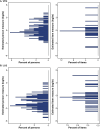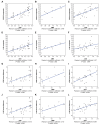Patient-Reported Outcomes in RLBP1 Retinal Dystrophy: Longitudinal Assessment in a Prospective Natural History Study
- PMID: 39541109
- PMCID: PMC11572762
- DOI: 10.1167/tvst.13.11.16
Patient-Reported Outcomes in RLBP1 Retinal Dystrophy: Longitudinal Assessment in a Prospective Natural History Study
Abstract
Purpose: To evaluate the performance of two non-disease-specific patient-reported outcome (PRO) instruments, the National Eye Institute Visual Function Questionnaire-25 (VFQ-25) and the Low Luminance Questionnaire (LLQ), in patients with retinaldehyde-binding protein 1 retinal dystrophy (RLBP1 RD).
Methods: PROs were assessed using the VFQ-25 and LLQ. Rasch analysis was conducted to estimate person and item measures of the VFQ-25 and LLQ questionnaires to determine the association between the two PROs. In addition, the association between these two instruments and their correlations to weighted measures of visual function and disease progression were analyzed in this three-year PRO-focused sub-study of a five-year prospective natural history study.
Results: Forty-two patients participated, with most of them having completed at least two PRO follow-up visits at least one year apart. The mean VFQ-25 scores were lowest for distance activities (39.2-49.0) and peripheral vision (37.5-52.4), with mean LLQ subscale scores generally low (<41), except for the emotional distress subscale. Using Rasch analysis, calibrated item and person measures along with their standard errors were estimated for both ePROs. This indicated that the distribution of the VFQ-25 and LLQ item measures well covered the distribution of person function in this group. This suggests that the item difficulties well cover the person-level performance in this population. As well, the two PROs showed a strong and significant correlation at all assessed time points as assessed with Pearson correlation coefficient (0.81, 0.91, 0.81 and 0.87 at baseline, 1/1.5, 2/2.5 (P < 0.001) and 3/3.5 years (P = 0.002)). The composite scores of both PRO questionnaires strongly correlated with clinical measures of visual function. At 2 to 2.5 years of follow-up, meaningful statistically significant declines in peripheral vision (both VFQ-25 and LLQ), distance vision (VFQ-25), and extreme lighting in dark and bright light (LLQ) subscales were noted.
Conclusions: This study demonstrated a strong association between VFQ-25 and LLQ scores and their association with clinical measures of visual function.
Translational relevance: PRO instruments can provide insights into the specific disabilities of this unique patient population and help to guide appropriate outcome measures for future clinical trials.
Conflict of interest statement
Disclosure:
Figures




References
-
- Hipp S, Zobor G, Glockle N, et al. .. Phenotype variations of retinal dystrophies caused by mutations in the RLBP1 gene. Acta Ophthalmol. 2015; 93: e281–e286. - PubMed
-
- Zhang X, Wen F, Hu S, Yan H, Lin S. Fundus angiography findings of atypical retinitis pigmentosa. Chin Ophthalmic Res. 2004; 22: 299–301.
-
- Botelho PJ, Blinder KJ, Shahinfar S.. Familial occurrence of retinitis punctata albescens and congenital sensorineural deafness. Am J Ophthalmol. 1999; 128: 246–247. - PubMed
-
- Demirci FY, Rigatti BW, Mah TS, Gorin MB.. A novel compound heterozygous mutation in the cellular retinaldehyde-binding protein gene (RLBP1) in a patient with retinitis punctata albescens. Am J Ophthalmol. 2004; 138: 171–173. - PubMed
Publication types
MeSH terms
Substances
LinkOut - more resources
Full Text Sources
Research Materials
Miscellaneous

